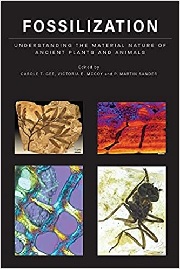Fossilization. Understanding the Material Nature of Ancient Plants and Animals

Edited by C.T.Gee, V.E.McCoy and M.P. Sander
John Hopkins University Press, £89.00
Fossils of various kinds are primary subjects in geological literature but how the process of fossilization occurs is varied and complex. How and why do some organisms die and disappear into the atmosphere and environment, whilst others die and their remains become preserved in sediments and/or volcanic materials that eventually become rocks and which provide key information on Earth and life history?
Many answers have been provided in the last few decades from a wide range of disciplines which address the issue from various time frames, age estimation, instrumentation, detailed imaging, plus a wide variety of temporal, biological and geological contexts. The 10 chapters, involving 16 contributors, document many of these developments.
Two chapters relate to fossil dinosaurs; they concern new finds of preserved dinosaur and tetrapod bone from Texas during the early Permian and the fossilization of hard and soft tissues linked with reproduction in non-avian dinosaurs and birds. Following on is a chapter on the value of Ramen spectroscopy in fossil research with a case study on an Acanthian fish spine of Devonian age. Amber and its arthropod inclusions are discussed in chapter five with emphasis on tissue preservation.
Chapters six and seven focus on wood beginning with lab-based experimental silicification and then the actual silica characteristics of mineralized wood. The substantial depth of the understanding of fossilization is then highlighted in chapters eight and nine. Chapter eight considers possible ecological interactions between plant defences and the four major expansions of Arthropod herbivory in geological time i.e. the Devonian, the Mid-Carboniferous, the Middle Triassic, and the late Early Cretaceous. Chapter nine examines a neglected issue of colour in fossil plants and the development of techniques to identify biochromes in the fossil record.
Although expensive, this book provides a welcome update of techniques and findings relevant to the fossil record.
Dr A M Mannion


